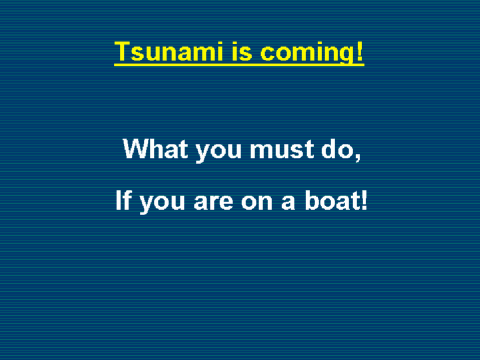| front |1 |2 |3 |4 |5 |6 |7 |8 |9 |10 |11 |12 |13 |14 |15 |16 |17 |18 |19 |20 |21 |22 |23 |24 |25 |26 |27 |28 |29 |30 |31 |32 |33 |34 |35|36 |37 |38 |39 |40 |41 |42 |43 |44 |45 |46 |47 |48|review |
 |
Since tsunami wave activity is imperceptible in the open ocean, do not
return to port if you are at sea and a tsunami warning has been issued for
your area. Tsunamis can cause rapid changes in water level and unpredictable
dangerous currents in harbors and ports.
If there is time to move your boat or ship from port to deep water (after a tsunami warning has been issued), you should weigh the following considerations: Most large harbors and ports are under the control of a harbor authority and/or a vessel traffic system. These authorities direct operations during periods of increased readiness (should a tsunami be expected), including the forced movement of vessels if deemed necessary. Keep in contact with the authorities should a forced movement of vessel be directed. Smaller ports may not be under the control of a harbor authority. If you are aware there is a tsunami warning and you have time to move your vessel to deep water, then you may want to do so in an orderly manner, in consideration of other vessels. Owners of small boats may find it safest to leave their boat at the pier and physically move to higher ground, particularly in the event of a locally-generated tsunami. Concurrent severe weather conditions (rough seas outside of safe harbor) could present a greater hazardous situation to small boats, so physically moving yourself to higher ground may be the only option. Damaging wave activity and unpredictable currents can effect harbors for a period of time following the initial tsunami impact on the coast. Contact the harbor authority before returning to port making sure to verify that conditions in the harbor are safe for navigation and berthing. Citation source: http://www.owlnet.rice.edu/~esci108/108_EQ_Lec_4.ppt
|